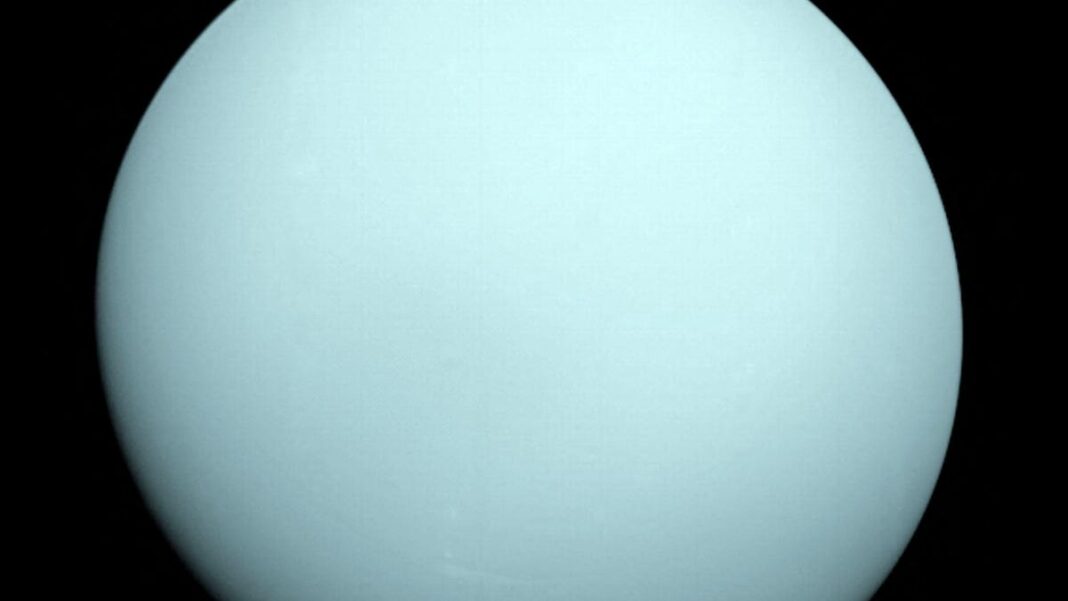Voyager 2 is the sole spacecraft to have explored Uranus, but its discoveries may have misled us for the past 40 years.
“The spacecraft encountered Uranus under circumstances that only happen around 4% of the time,” stated the lead researcher of a new paper.
The solitary journey of a spacecraft to Uranus might have provided us with an entirely misleading perception of the ice giant for nearly four decades.
The oddly tilted planet – the third largest in our solar system – has remained somewhat enigmatic to astronomers. However, when Voyager 2 closely examined Uranus in 1986, scientists gained valuable insights that, while perplexing, at least illuminated a significant trait differentiating the planet from other gas giants such as Jupiter.
Or so they believed.
A new analysis of the data gathered during the Voyager 2 flyby suggests that the probe’s observation may have coincided with a rare interstellar phenomenon. Findings released on Monday in a study published in the journal Nature Astronomy indicate that our comprehension of the planet’s protective magnetic field, known as its magnetosphere, could be incorrect.
“If Voyager 2 had arrived just a few days sooner, it would have witnessed an entirely different magnetosphere at Uranus,” commented Jamie Jasinski, the study’s lead author and a physicist at NASA’s Jet Propulsion Laboratory in Pasadena, California. “The spacecraft experienced conditions that occur only about 4% of the time.”
Voyager 2’s historic visit to Uranus in 1986
Our knowledge about Uranus primarily stems from Voyager 2’s flyby, which still stands as the only instance when a spacecraft has approached the planet.
Both Voyager 1 and Voyager 2 were launched in 1977 from Cape Canaveral, Florida, to investigate the outer reaches of our solar system. These probes are presently traveling billions of miles away and have both reached interstellar space—Voyager 1 in 2012 and Voyager 2 in 2018, as reported by NASA.
Before reaching interstellar space, Voyager 2 made a close pass of Uranus, coming within 50,600 miles of its cloud tops. During its encounter on January 24, 1986, the probe transmitted detailed photographs and a wealth of data about the planet, its moons, magnetic field, and faint rings.
Why is Uranus’ magnetosphere of interest to scientists?
For decades, data from Voyager 2 regarding Uranus’ magnetosphere has puzzled scientists.
Magnetospheres serve as protective shields around planets with magnetic cores and fields, safeguarding them from harmful solar winds composed of gas and plasma. Researchers have long been keen to study the magnetospheres of other planets to gain insights into our own planet’s magnetic protection.
Uranus’ magnetosphere has been particularly intriguing due to radiation belts exhibiting an unexpected intensity comparable to those of Jupiter.
Adding to the mystery was the lack of plasma, which typically consists of energetic ionized particles found in other planetary magnetospheres. Scientists anticipated that the five significant moons of Uranus should contribute to this plasma within the magnetosphere.
However, Voyager 2’s data led researchers to conclude that these moons must be inactive.
Solar wind may have distorted Voyager’s findings: New Study
This led to Uranus being regarded as an unusual entity within our solar system for many years.
Recent studies suggest that this perspective could be changing.
By an unintended coincidence, Voyager 2’s flyby may have occurred during a period of unusual space weather, which influenced Uranus’s magnetic field and distorted the spacecraft’s observations. The solar winds interacting with the magnetosphere could have temporarily expelled plasma while simultaneously increasing the magnetosphere’s power, according to the latest research.
Instead of a comprehensive view of Uranus, scientists on Earth received a deceptive “snapshot in time,” according to Linda Spilker, the project scientist for the twin Voyager probes at JPL.
This suggests that the five significant moons of Uranus could still be geologically active.
“This new research clarifies some previous inconsistencies and will reshape our understanding of Uranus again,” stated Spilker, who was involved with the Voyager 2 mission.
Is NASA Planning to Revisit Uranus?
The authors of the study emphasize how limited our knowledge of Uranus is and underscore the importance of future missions to the planet.
A 2022 report by the National Academies of Sciences, Engineering, and Medicine urged NASA to prioritize another mission to Uranus within the next ten years, which the agency appears to be moving towards.
Plans detailed in a 2023 Scientific American report suggest that NASA intends to launch a spacecraft by 2032 to orbit Uranus and deploy a probe into its atmosphere.

